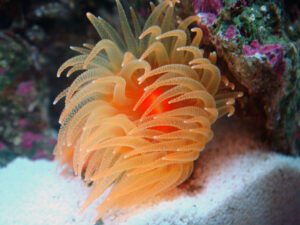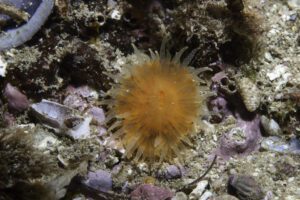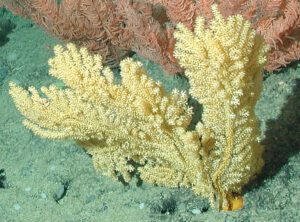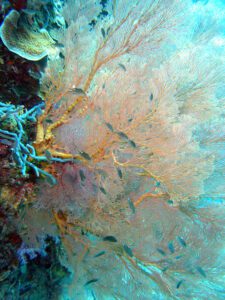Table of Contents
General information
Non-photosynthetic corals, also known as NPS corals, form a unique category of marine organisms that do not rely on sunlight for energy production. These remarkable corals obtain all necessary nutrients directly from the water. One of their characteristic features is the ability to live in less illuminated areas of the reef. Providing these corals with optimal water conditions, including proper salinity and levels of calcium (Ca) and magnesium (Mg), is crucial to maintaining them in ideal health. An important aspect of care is also the feeding method by precisely delivering food directly to the polyps.
For those who wish to deepen their knowledge about caring for these corals, we have prepared an article titled “How to Care for Non-Photosynthetic Corals in a Saltwater Aquarium“. It contains comprehensive information and practical tips that will help both novice and experienced aquarists in the optimal care of these unique corals.
Below is a description of eight popular NPS species, which are among the most common and eagerly cultivated in saltwater aquariums.
Tubastraea faulkneri

Occurrence: Coral reefs of the Indo-Pacific, including the Great Barrier Reef and the Philippines.
Description: Bright, orange-yellow polyps that grow in shaded areas. Polyps of this variety can reach up to 1.5 cm in diameter. Colonies consist of many individual polyps, which together can form structures up to several centimeters in diameter.
Conditions: The optimal water temperature is 25-27°C, pH should be between 8.1 and 8.4, carbonate hardness of the water should be 8-12 dKH, salinity should be 1.023-1.025 SG, and calcium levels should be at 425 ppm. Stability of these parameters is crucial, with low nitrate levels (1-5 ppm) and phosphate levels (0.01-0.04 ppm). Water circulation should be moderate to strong.
Feeding: Daily, consisting of a mix of small food particles like mysis and smaller zooplankton such as cyclops.
Dendrophyllia

Source: https://www.flickr.com/photos/50049718@N06/5690305673/in/photolist-6jNqve-9EQiCv-6LpcDS-5Z2tZW-6kn7BP-5YXghz-agQq8a-6L48j3-gkJcrd-gkzcqF
Occurrence: Deep waters of coral reefs, often in shaded areas.
Description: These corals have a variety of colors, ranging from golden to red. Dendrophyllia often develop into irregular, branching structures, with each polyp reaching up to 2 cm in length.
Conditions: They require low lighting and stable water parameters, with a temperature of 22-26°C, pH between 8.1 and 8.4, carbonate hardness of the water at 8-12 dKH, and salinity at 1.023-1.025 SG. It is recommended to maintain calcium (Ca) levels at 400-450 ppm and magnesium (Mg) around 1200 ppm. Water circulation should be moderate to strong.
Feeding: Regular, rich in various types of meaty foods such as mysis, brine shrimp, and liquid preparations containing zooplankton.
Rhizotrochus

Source: https://www.saltcorner.com/AquariumLibrary/browsespecies.php?CritterID=2481
Occurrence: Rare, mainly in the waters of Japan.
Description: They are characterized by large, distinct polyps that can be very colorful and grow up to 2-3 cm in diameter.
Conditions: They prefer moderate lighting and medium water flow. Temperature should be 25-27°C, pH between 8.1 and 8.4, carbonate hardness of the water at 8-12 dKH, and salinity at 1.023-1.025 SG. Calcium (Ca) levels should be between 380-450 ppm and magnesium (Mg) within the range of 1250-1350 ppm.
Feeding: Meaty foods such as mysis, brine shrimp. Additionally, finely chopped seafood like squid and mussels.
Balanophyllia

Source: https://www.inaturalist.org/photos/96619683
Occurrence: Found in the Atlantic Ocean, in deep and shaded areas.
Description: Small, growing as individual, solitary polyps with an oval shape and a diameter of about 1-2 cm. Known for their vivid and diverse range of colors, they typically occur in red, orange, pink, lime, green, or brown hues.
Conditions: Moderate light, medium water flow, temperature of 22-26°C, pH between 8.1-8.4. Carbonate hardness of the water should be 8-12 dKH, salinity at 1.023-1.025 SG. Calcium (Ca) levels in the range of 400-450 ppm, and magnesium (Mg) between 1250-1350 ppm.
Feeding: Artemia or mysis every day or every other day, and you can also feed rotifers.
Gorgonia sp.

Source: https://commons.wikimedia.org/wiki/File:Gorgonia_ventalina,_Cuba_3.jpg
Occurrence: Diverse environments, from subtropical Bahamas to the Indo-Pacific.
Description: Fan-shaped corals with stiff, often very colorful polyps. Gorgonian polyps are typically small, but the colonies themselves can grow to several meters in height, depending on the species.
Conditions: Moderate light, strong water flow; temperature of 22-26°C, pH between 8.1-8.4. Carbonate hardness of the water should be in the range of 8-11 dKH, salinity at 1.025 SG. Stable conditions with an appropriate level of calcium (Ca) at 380-450 ppm and magnesium (Mg) in the range of 1250-1350 ppm.
Feeding: It is recommended to feed plankton, cyclops, and artemia at least three times a week.
Subergorgia sp.

Occurrence: Mainly on coral reefs in Southeast Asia.
Description: Large, flexible polyps that can display various colors ranging from red to yellow. Polyps of this species can reach up to 1 cm in length, and entire colonies often grow to sizes of several tens of centimeters.
Conditions: They prefer strong water flow, which aids in catching food, and moderate lighting. Water temperature should be between 22-26°C, pH between 8.1-8.4, carbonate hardness in the range of 8-11 dKH, salinity at 1.025 SG. Recommended calcium (Ca) concentration is 400-450 ppm, magnesium (Mg) around 1250-1350 ppm.
Feeding: Regular, at least every two days, providing cyclops, artemia, and mysis, as well as nannochloropsis, isochrysis, and tetraselmis.
Acanthogorgia sp.

Source: https://commons.wikimedia.org/wiki/File:Acanthogorgia-_Gold_coral-_noaa.jpg
Occurrence: Found in various parts of the Indo-Pacific.
Description: It has a flexible skeleton covered with small, usually no longer than 1 cm, evenly distributed polyps. These corals can display various colors, from reds and oranges to greens and browns, making them extremely attractive.
Conditions: Moderate light and strong water flow, temperature of 25-27°C, pH between 8.1-8.4, carbonate hardness in the range of 8-11 dKH, salinity at 1.025 SG. It requires a stable level of calcium (Ca) at 380-450 ppm and magnesium (Mg) around 1200 ppm.
Feeding: Regular feeding by providing mysis, artemia, and rotifers.
Melithaea ochracea

Source: http://www.colors.dk/anders/diving/corals/gorgonian/gorgonian.html
Occurrence: Mainly found in waters around Taiwan and Southeast Asia.
Description: It resembles a branching fan with many small polyps that can be intensely colorful, typically not exceeding 0.5 cm in size. Colonies can form elaborate structures of considerable size.
Conditions: Strong water flow and moderate light, temperature of 22-26°C, pH between 8.1-8.4. Carbonate hardness of the water should be 8-12 dKH, salinity at 1.025 SG. Calcium (Ca) levels should be between 400-450 ppm, and magnesium (Mg) between 1250-1350 ppm.
Feeding: Feeding should be regular, ideally several times a week, to provide a continuous source of food for the corals such as rotifers, artemia, mysis, or preparations containing zooplankton.
Summary
Non-photosynthetic corals described above have diverse colors and shapes, making them incredibly beautiful marine organisms. Keeping them requires stable water conditions, including proper salinity, calcium (Ca), magnesium (Mg), and carbonate hardness (kH). It’s important to provide them with appropriate water flow to help them catch food from the water column. However, the flow shouldn’t be too strong directly on the corals to avoid hindering their opening.
These corals need regular feeding of zooplankton and microplankton, ideally several times a week. Feeding should be done by directly delivering food to the polyps using a needle-less syringe, ensuring effective delivery without dispersing food throughout the aquarium. Moderate water flow helps spread food around the polyps, allowing the corals to catch and consume it.
Regular attention to these aspects is crucial for maintaining the health and vitality of these fascinating corals.
About the author

Grzegorz Bubak
My fascination with marine aquariums began over two decades ago when I stumbled upon an article about this topic in a magazine. Since then, the underwater world has become my obsession and passion, shaping my everyday life. I started my adventure with marine aquariums with soft corals, which were my first step into this fascinating world. Over time, captivated by the diversity and beauty of SPS corals, I decided to focus on their cultivation, which continues to fill me with constant wonder.
Thanks to my experience and passion for marine aquariums, I am ready to share my knowledge and expertise with other enthusiasts in this field. I am happy to be part of the Reef Pedia community, which serves as an invaluable source of information for all marine aquarium lovers.

